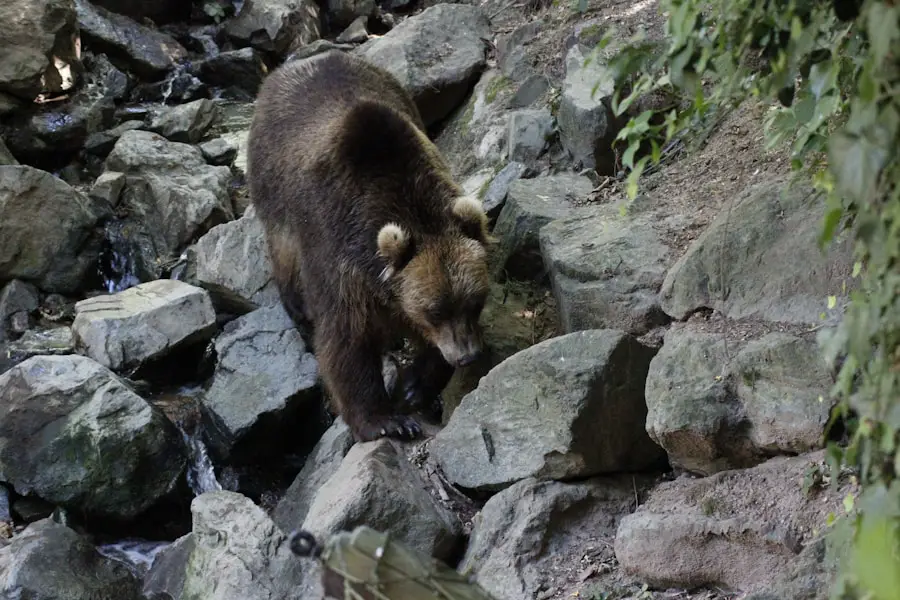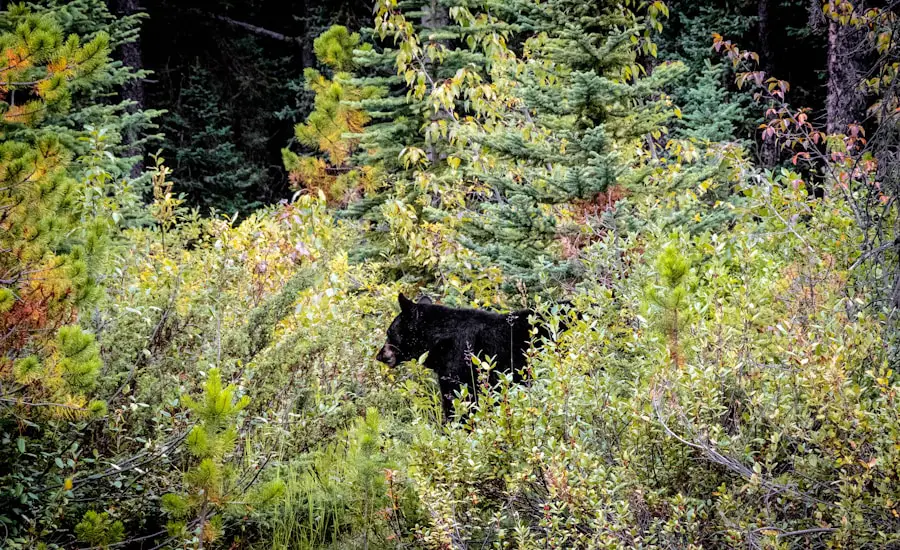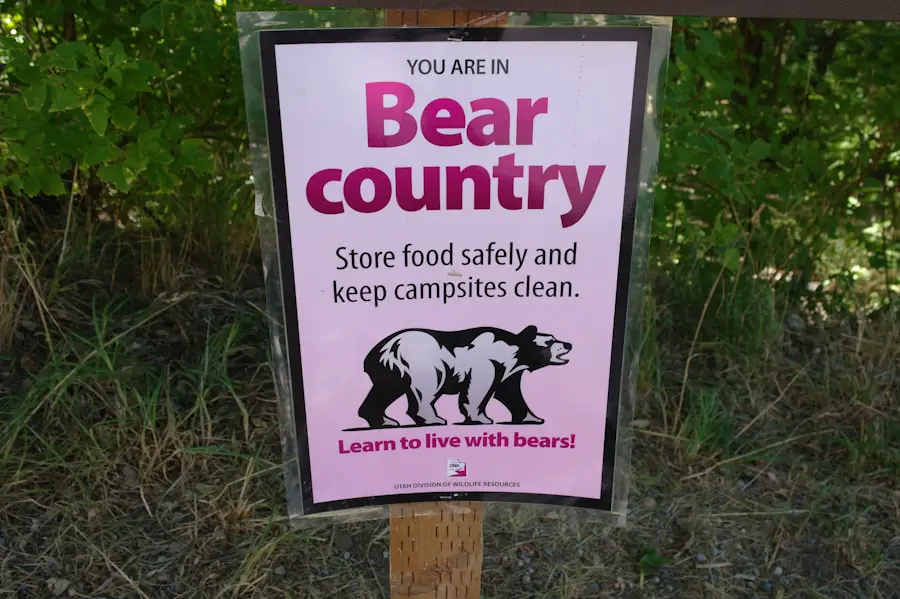Bears are complex creatures with behaviors that can be influenced by a variety of factors, including their species, environment, and individual experiences. Understanding bear behavior is crucial for anyone who ventures into bear habitats, whether for recreation or work. Bears are generally solitary animals, except during mating season or when a mother is raising her cubs.
They exhibit a range of behaviors that can indicate their mood or intentions. For instance, a bear that is foraging for food may appear calm and focused, while a bear that feels threatened may display defensive behaviors such as huffing, growling, or standing on its hind legs to assess the situation. Bears are also highly intelligent and adaptable animals.
They have excellent memories and can remember the locations of food sources for years. This adaptability means that they can thrive in various environments, from dense forests to mountainous regions. Their behavior can change with the seasons; for example, during the spring and summer months, bears are more active and focused on feeding to build fat reserves for hibernation.
In contrast, as winter approaches, their behavior shifts towards seeking out denning sites where they will hibernate. Understanding these seasonal patterns can help individuals anticipate bear activity and reduce the likelihood of encounters.
Key Takeaways
- Bears are generally shy and will avoid human contact if given the chance.
- Make noise while hiking to alert bears of your presence and carry bear spray as a precaution.
- Grizzly bears are larger and have a distinctive hump on their shoulders, while black bears are smaller and lack the hump.
- If you encounter a bear, remain calm, avoid eye contact, and slowly back away while speaking softly.
- Bear deterrents such as bear spray and noise-making devices can help deter a bear from approaching.
Preparing for a Bear Encounter
Preparation is key when venturing into areas inhabited by bears. One of the most effective ways to prepare is to educate oneself about bear behavior and the specific species that inhabit the area. Knowledge about the local bear population can inform decisions about when and where to hike, camp, or engage in other outdoor activities.
For instance, areas known for high bear activity may require additional precautions, such as traveling in groups or making noise to alert bears of human presence. In addition to education, carrying appropriate gear is essential. Bear spray is a widely recommended deterrent and should be easily accessible at all times.
It is also advisable to have a whistle or an air horn to make noise in case of an encounter. Proper food storage techniques are critical as well; using bear-proof containers or hanging food in trees can significantly reduce the chances of attracting bears to campsites. Furthermore, understanding how to set up a campsite away from bear trails and natural food sources can minimize risks.
Identifying Different Types of Bears

There are several species of bears found across North America, each with distinct characteristics and behaviors. The most common species include the American black bear, the brown bear (which includes grizzly bears), and the polar bear. The American black bear is typically smaller than its brown counterpart and has a more varied diet, often foraging for fruits, nuts, and insects.
They can be found in forests, swamps, and even urban areas, making them one of the most frequently encountered bears. Brown bears are larger and more powerful than black bears, with a distinctive hump on their shoulders due to their muscle mass. They are often found in coastal regions where they can access salmon during spawning seasons.
Grizzly bears, a subspecies of brown bears, are known for their aggressive behavior when protecting their cubs or food sources. Polar bears, while not typically encountered in most bear habitats, are adapted to cold climates and primarily hunt seals on sea ice. Understanding these differences is vital for recognizing potential threats and responding appropriately during encounters.
Reacting to a Bear Sighting
| Location | Number of Bear Sightings | Actions Taken |
|---|---|---|
| Yellowstone National Park | 117 | Evacuation of campgrounds, warning signs posted |
| Alaska | 89 | Local authorities notified, bear safety education provided |
| Rocky Mountain National Park | 45 | Trails closed, bear management team dispatched |
When encountering a bear in the wild, the initial reaction can significantly impact the outcome of the situation. The first step is to remain calm and avoid sudden movements that could startle the bear. It is essential to assess the bear’s behavior; if it appears curious but not aggressive, it may be best to slowly back away while keeping an eye on the animal.
Making noise can also help signal your presence without provoking the bear; talking in a calm voice or clapping hands can alert the bear without escalating the situation. If the bear approaches or shows signs of aggression—such as growling or charging—it’s crucial to stand your ground. Many people instinctively want to run, but this can trigger a chase response in bears.
Instead, maintaining eye contact and speaking firmly can help assert your presence as a non-threat. If the bear continues to approach despite your efforts to deter it, preparing to use bear spray should be your next step. Knowing how to use it effectively—aiming slightly downward at the bear’s face—can make all the difference in deterring an aggressive animal.
Using Bear Deterrents
Bear deterrents play a vital role in preventing encounters and ensuring safety in bear country. Bear spray is one of the most effective tools available; it contains capsaicin, which causes temporary blindness and respiratory distress in bears when sprayed directly at them. It is essential to carry bear spray in an easily accessible location and practice using it before heading into the wilderness.
Familiarity with its operation can save precious seconds during an encounter. In addition to bear spray, other deterrents include noise-making devices such as bells or whistles that can alert bears to human presence while hiking or camping. These sounds can help prevent surprise encounters by allowing bears to move away from your path before you arrive.
Additionally, using proper food storage techniques—such as storing food in bear-proof containers or hanging it from trees—can significantly reduce the likelihood of attracting bears to campsites. By employing these deterrents effectively, outdoor enthusiasts can minimize risks associated with bear encounters.
Reacting to a Charging Bear

A charging bear can be one of the most frightening experiences one might face in the wilderness. The first step in reacting appropriately is understanding that not all charges are aggressive; sometimes bears charge out of curiosity or as a bluff. However, if a bear charges with intent—especially if it is a mother with cubs—knowing how to respond can be life-saving.
The general advice is to stand your ground rather than run away; running may trigger a chase response. If a bear charges within close range, deploying bear spray should be your immediate action if you have it available. Aim for the bear’s face while standing firm; this will create a barrier between you and the animal that may deter it from coming closer.
If you do not have bear spray and the bear makes contact, playing dead may be your best option in certain situations—especially with grizzly bears—by lying flat on your stomach with your hands clasped behind your neck to protect vital areas. This behavior signals submission and may cause the bear to lose interest after assessing you as no longer a threat.
Reporting Bear Encounters
Reporting bear encounters is an essential aspect of wildlife management and safety in areas where bears are prevalent. When individuals encounter bears—whether they are aggressive or simply sighted—it is crucial to report these incidents to local wildlife authorities or park rangers. This information helps wildlife officials monitor bear populations and behaviors, allowing them to implement necessary measures for public safety and conservation efforts.
When reporting an encounter, providing detailed information is vital. This includes the location of the sighting, time of day, weather conditions, and any specific behaviors exhibited by the bear. Such data can assist wildlife managers in understanding patterns of bear activity and identifying potential problem areas where human-bear interactions may increase.
Additionally, sharing experiences with fellow outdoor enthusiasts through community forums or social media can raise awareness about safety practices and encourage others to take precautions when exploring bear habitats.
Seeking Medical Attention
In the unfortunate event of a bear attack or injury during an encounter, seeking medical attention should be a top priority. Even minor injuries can become serious if not treated promptly due to potential infections or complications from animal bites or scratches. It is essential to assess injuries immediately after an encounter; if there are any wounds—no matter how small—cleaning them thoroughly and applying antiseptic is crucial before seeking professional medical care.
In cases where injuries are severe or involve significant trauma, calling emergency services should be done as soon as possible. Providing first responders with information about the incident can help them prepare for any specific medical needs related to animal attacks. Additionally, documenting injuries through photographs may be beneficial for medical records or potential legal matters related to wildlife encounters.
Understanding how to respond effectively after an encounter not only aids personal recovery but also contributes to broader efforts in wildlife safety and management.
If you’re out hiking and come across a bear, it’s important to know how to react to ensure your safety. One helpful article on TakeTravelInfo.com provides tips on what to do if you encounter a bear while hiking. This article offers valuable advice on how to handle the situation calmly and safely. For more travel-related articles and tips, you can visit TakeTravelInfo.com.
Love travel? Join Our Facebook Community For More Tips.
FAQs
What should I do if I see a bear while hiking?
If you see a bear while hiking, it’s important to remain calm and avoid sudden movements. Back away slowly while facing the bear and try to make yourself look as large as possible.
Should I run if I encounter a bear while hiking?
No, running can trigger a bear’s predatory instincts and may cause it to chase you. It’s best to back away slowly while facing the bear and speaking in a calm, assertive voice.
What should I do if a bear approaches me while hiking?
If a bear approaches you while hiking, stand your ground and make yourself look as large as possible. Use a loud, assertive voice to let the bear know you are not a threat. If the bear continues to approach, use bear spray if you have it and slowly back away.
Should I climb a tree if I encounter a bear while hiking?
Climbing a tree is not a safe option if you encounter a bear while hiking. Bears are excellent climbers and can easily reach you in a tree. It’s best to slowly back away while facing the bear and speaking in a calm, assertive voice.
What should I do if a bear charges at me while hiking?
If a bear charges at you while hiking, stand your ground and use bear spray if you have it. If the bear makes contact, play dead by lying on your stomach with your hands clasped behind your neck and legs spread apart to make it harder for the bear to flip you over. Once the bear loses interest, continue to play dead until you are sure the bear has left the area.
